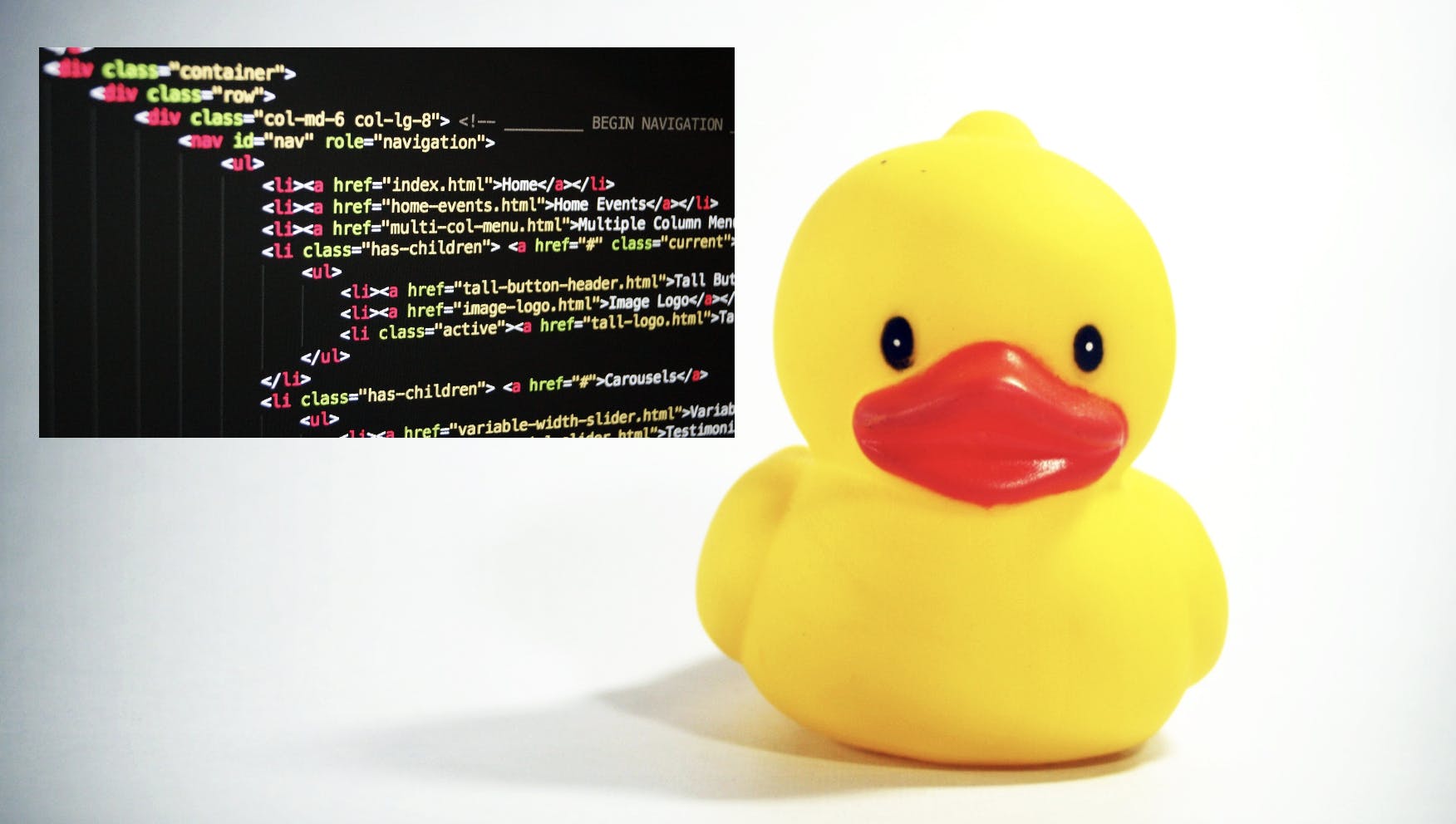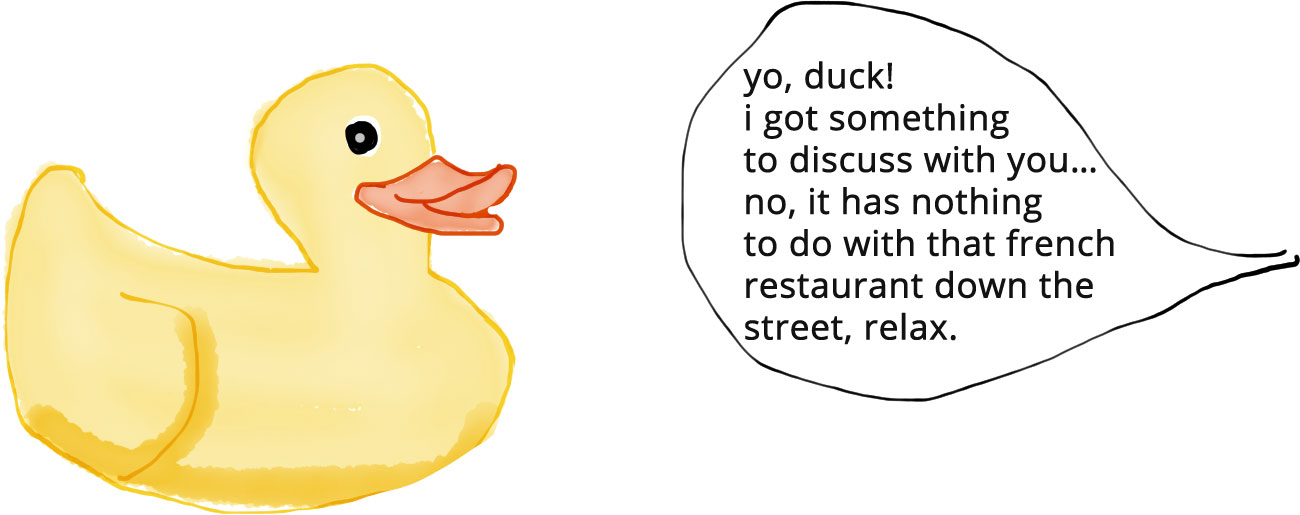
Rubber Duck Debugging. Well you’re stuck, talk to the rubber… by Slim Ayache Medium
"Rubber duck debugging" is a reference to a story in a programming book called The Pragmatic Programmer: From Journeyman to Master by Andrew Hunt and David Thomas. In it, a programmer would carry around a rubber duck and debug their code by forcing themselves to explain it, line-by-line, to the duck. Why Does Rubber Duck Debugging Work?
Quack quack! Have you tried Rubber Duck Debugging? Overleaf, Online LaTeX Editor
Rubber Duck Debugging - How to Solve a Problem Coder Foundry 99.4K subscribers Join Subscribe Subscribed 1.1K 39K views 4 years ago 👨🏫 Self-Paced .NET Bootcamp Course (includes FREE courses).

Can I be Your Rubber Duck? Debugging Code With a Friend ExaVault Blog
What is Rubber Duck Debugging? In the world of software engineering, a rubber duck method helps to debug codes. It helps you to find bugs and problems in your code. The term rubber duck refers to an entity that has less than half a brain and understands almost nothing about a given problem.

Rubber Duck Debugging How to Solve a Problem YouTube
Rubber duck debugging. Rubber duck debugging is the process of explaining our code, step-by-step, to a rubber duck (or some other inanimate object), so we ourselves can understand it better and hopefully realize where we might have a bug or opportunity of improvement. Hopefully, this will be another simple, but powerful, tool for us to use..

Improve how you code Understanding Rubber Duck Debugging
There's an established programming practice called rubber duck debugging which is, in my experience, guaranteed to increase productivity and speed your learning. The practice is very simple. To quote The Pragmatic Programmer: A very simple but particularly useful technique for finding the cause of a problem is simply to explain it to someone.

Maryanne Jones Mal by podnos rubber duck debugging pulz kaderník názov
The rubber duck debugging method is as follows: Beg, borrow, steal, buy, fabricate or otherwise obtain a rubber duck (bathtub variety). Place rubber duck on desk and inform it you are just going to go over some code with it, if that's all right. Explain to the duck what your code is supposed to do, and then go into detail and explain your.

FileRubber duck assisting with debugging.jpg Wikimedia Commons
Understanding the Problem. By explaining your problem out loud to the rubber duck, you have to articulate: A. What your program is _supposed_ to do (i.e. the desired behavior) B. What your program is _actually doing_. The process of debugging our code is really just the journey from A to B. By stating these two things out loud, we can often see.

Rubber duck debugging ProgrammerHumor
Rubber Ducky Debugging is a technique that involves explaining your code to a rubber duck or any inanimate object, essentially talking to yourself to identify potential problems in the code. The idea is that by explaining your code line by line, you can identify mistakes or areas that may need improvement. The rubber duck or inanimate object.

What is Rubber Duck debugging does it work? BrightMinded
Rubber duck debugging is a popular software development technique that can help you debug your code faster. The basic idea is simple: when you get stuck on a problem, explain it to someone—or even better, to a rubber duck. By talking through your code, you can often work out the solution yourself. Not only does this technique help you debug.

Rubber Ducky Debugging! DEV Community
The term "rubber duck debugging" was coined in the early 2000s, and it has since become a widely recognized term in the software development community. It is often used humorously, but the rubber duck debugging method itself has proven to be an effective way for developers to catch errors and solve problems.

Rubber Duck Debugging Lesson Teaching Resources
The rubber duck debugging method is as follows: Beg, borrow, steal, buy, fabricate or otherwise obtain a rubber duck (bathtub variety). Place rubber duck on desk and inform it you are just going to go over some code with it, if that's all right.

Rubber Duck Debugging The best way to debug your code that you've never tried SelfTaught Coders
It is called rubber duck debugging and it works a charm for finding a way out of a tangled mess. The steps are simple: First, get yourself a small, bathtub-variety rubber duck. If no ducks are immediately available, any non-threatening inanimate object will do. Next, with the object in front of you, tell it your problem.

What is Rubber Duck Debugging? Kenzie Academy
The art of Rubber Ducking or Rubber Duck Debugging. It works. Really. "Put a rubber duck on your monitor and tell it how the code is supposed to work." The Rubber Duck can be your disinterested roommate, non-technical spouse, or your work-spouse. I call Damian Edwards or Tara Walker all the time and they just listen to me explain how it should.

devDucks Rubber Duck Debugging by devRant Rubber duck, Rubber duck debugging, Duck
The Psychology of Rubber Duck Debugging's Effectiveness: Two Shifts. If you're like most, when you're explaining something to someone else two important things shift in your head. First, you're likely to slow down and be more exacting than you are when you're power-typing code. Most of us think way faster than we talk.

The art of Rubber Ducking or Rubber Duck Debugging DevsDay.ru
What is Rubber Duck Debugging and How Does it Work? The rubber duck debugging technique was popularized by a story from the 1999 book written by Andrew Hunt and David Thomas - The Pragmatic Programmer. The story depicts how a programmer carries around a rubber duck and explains their codes to it line by line any time they encounter a bug.

Rubber Duck Debugging Teaching Resources
Experiments with GPT-4 demonstrate the effectiveness of our approach, outperforming rubber duck debugging in easy and medium-level Leetcode problems by 1.5% and 17.9%. Subjects: Computation and Language (cs.CL); Software Engineering (cs.SE) Cite as: arXiv:2401.05319 [cs.CL] (or arXiv:2401.05319v1 [cs.CL] for this version)